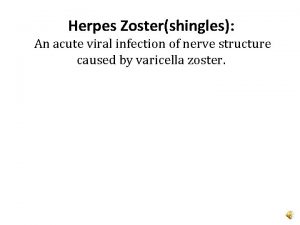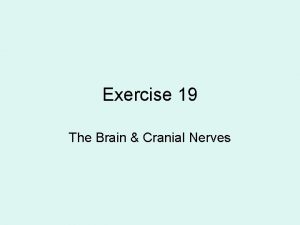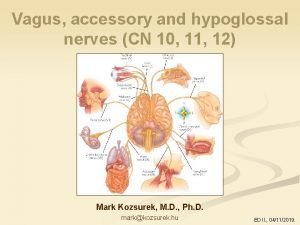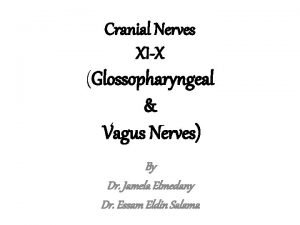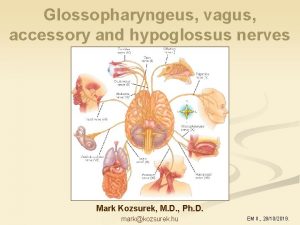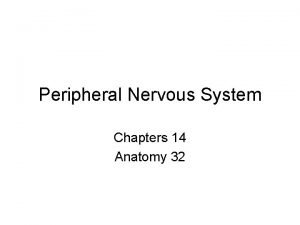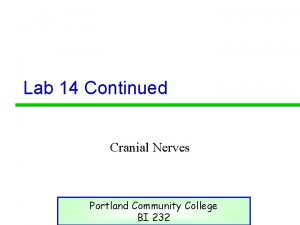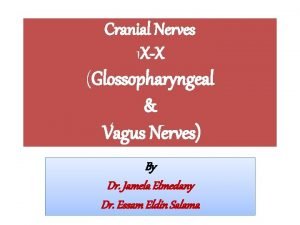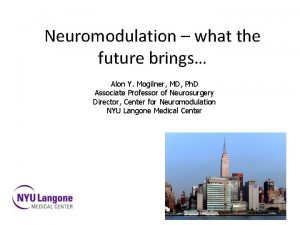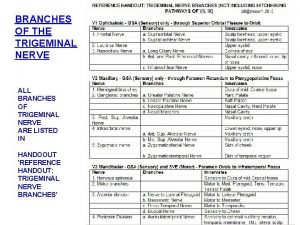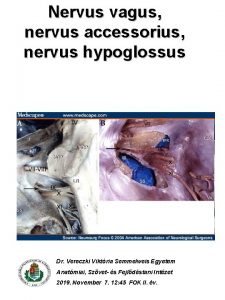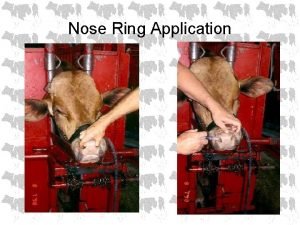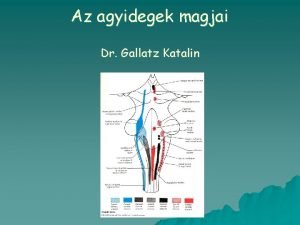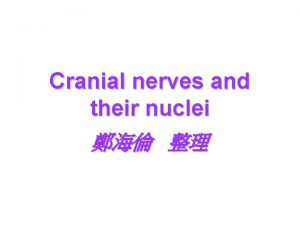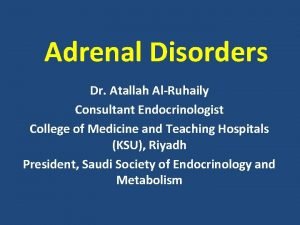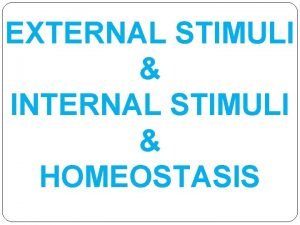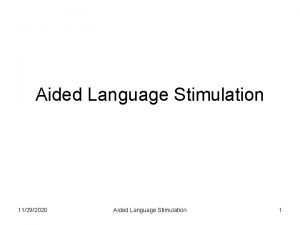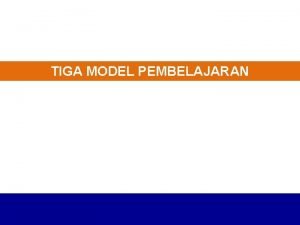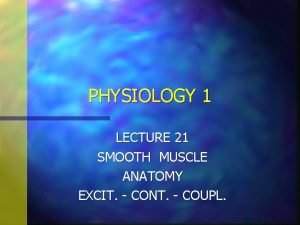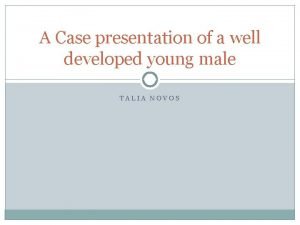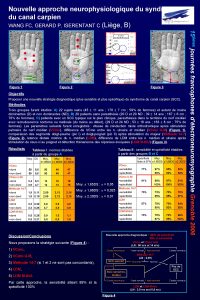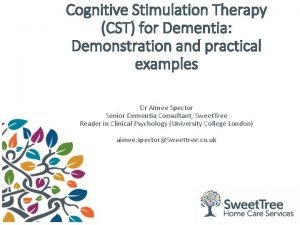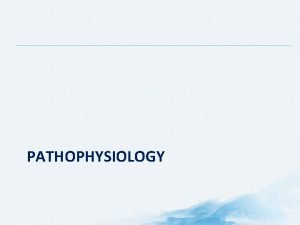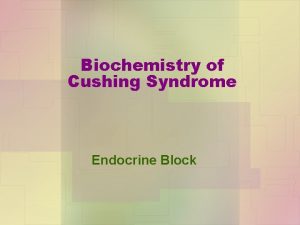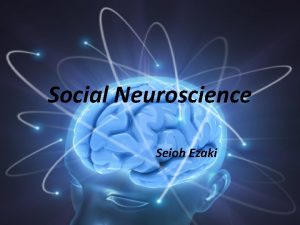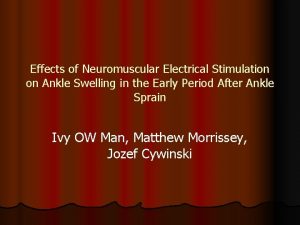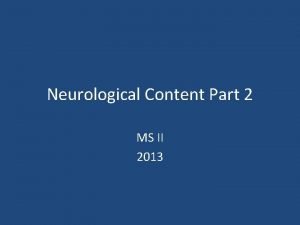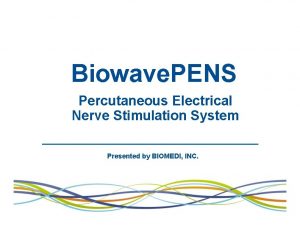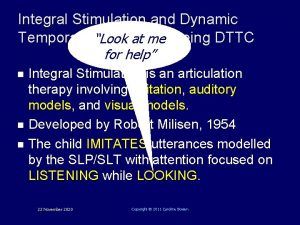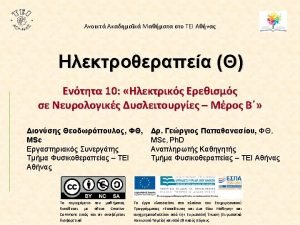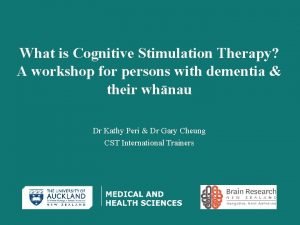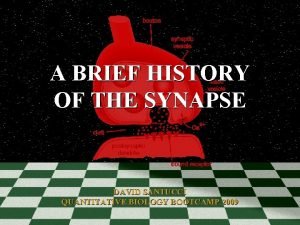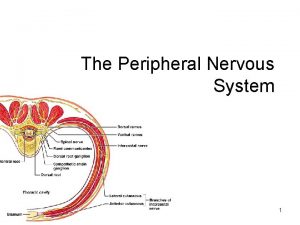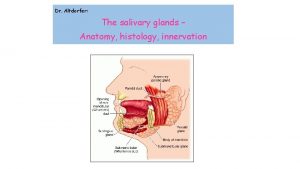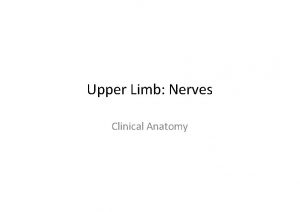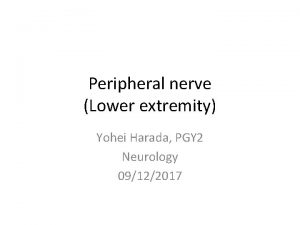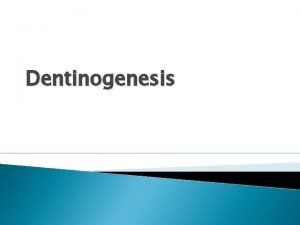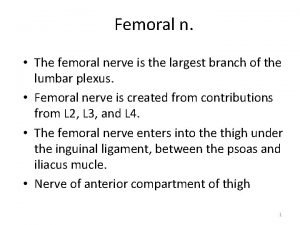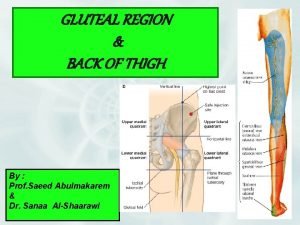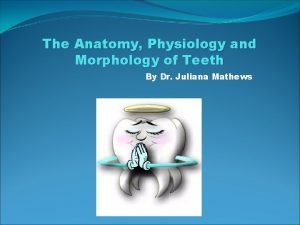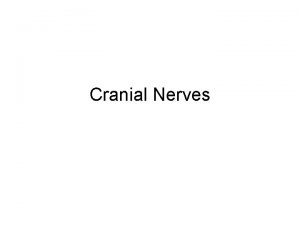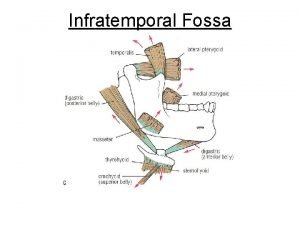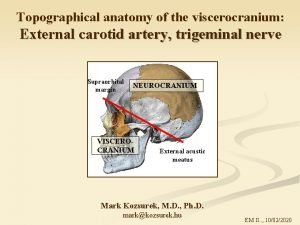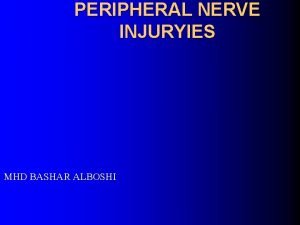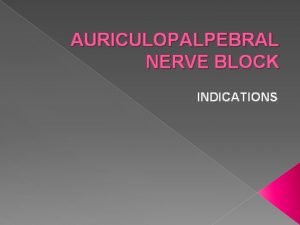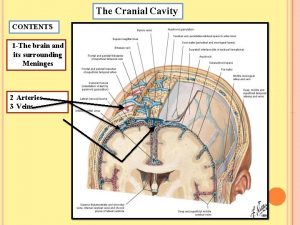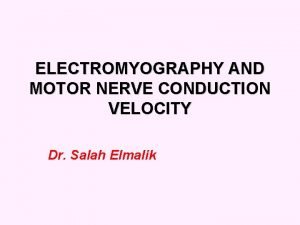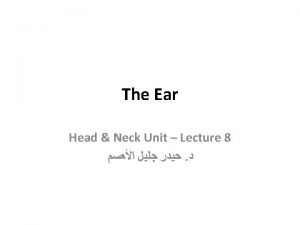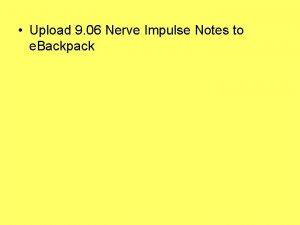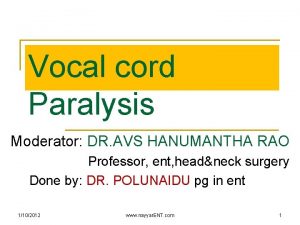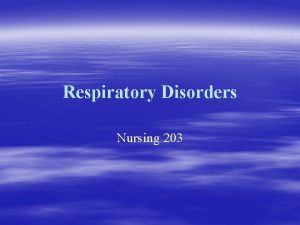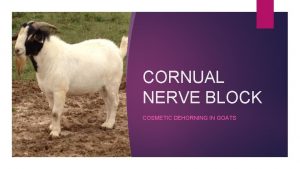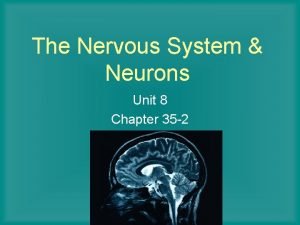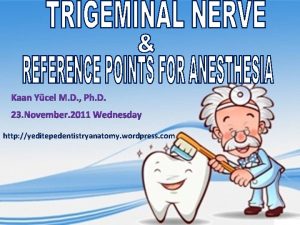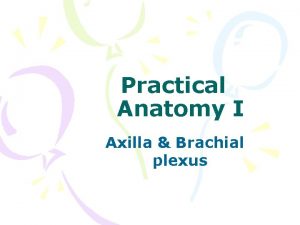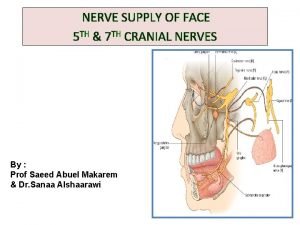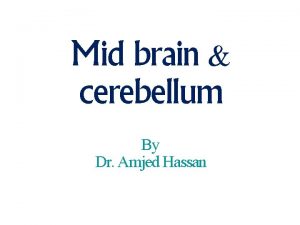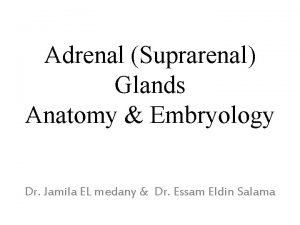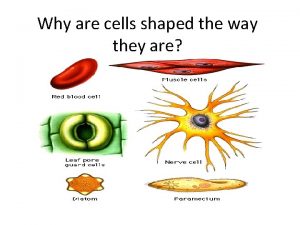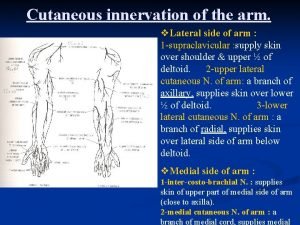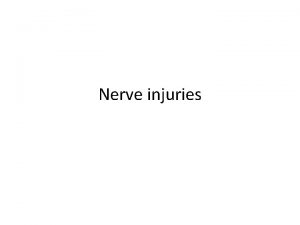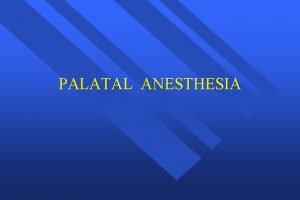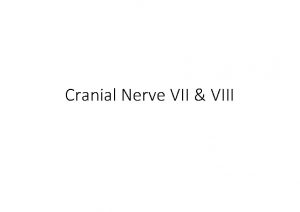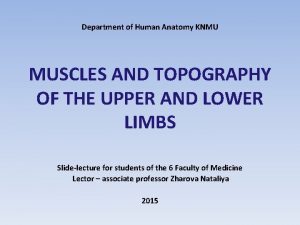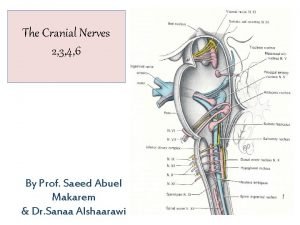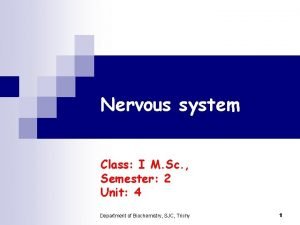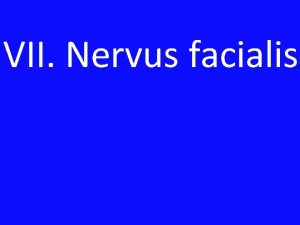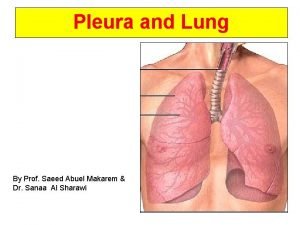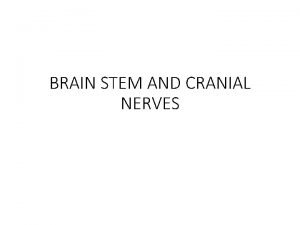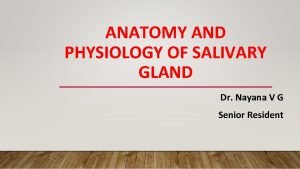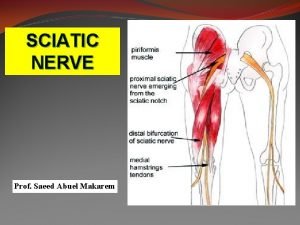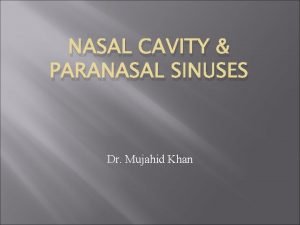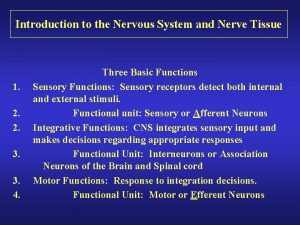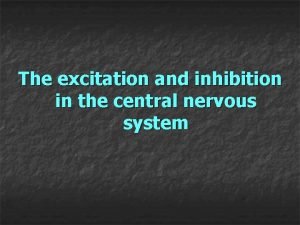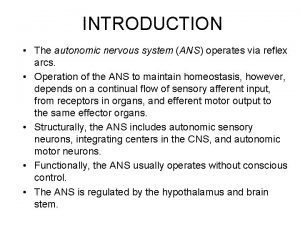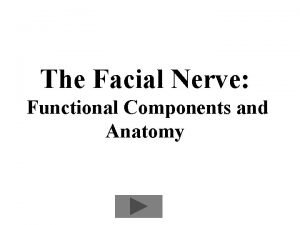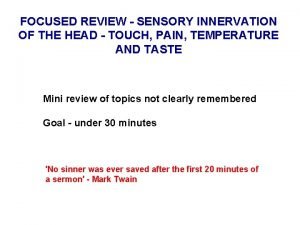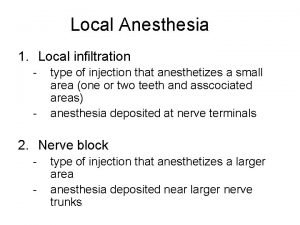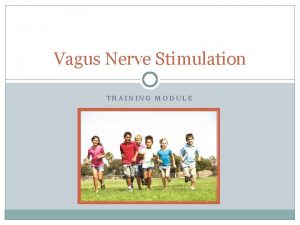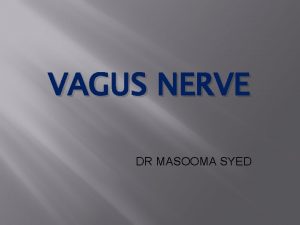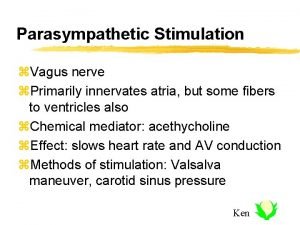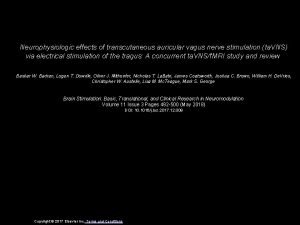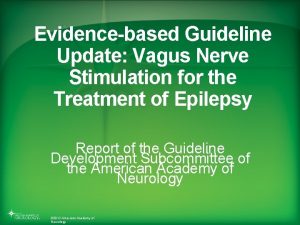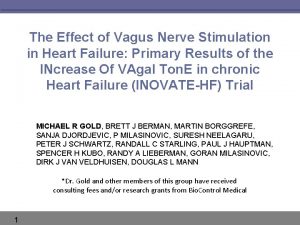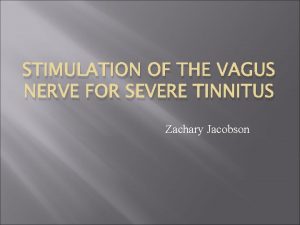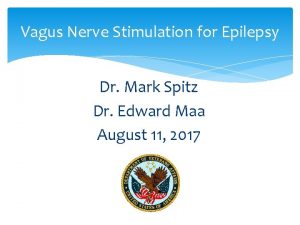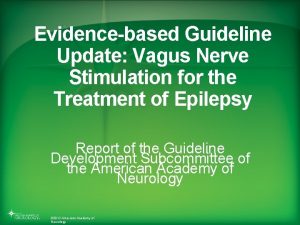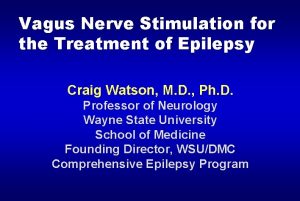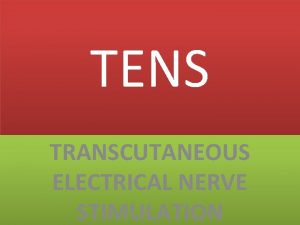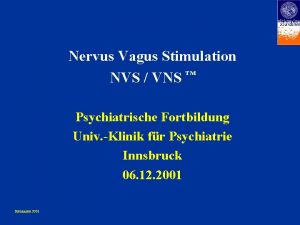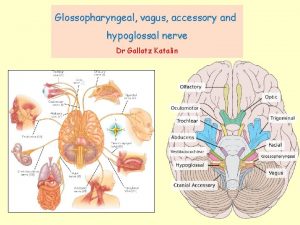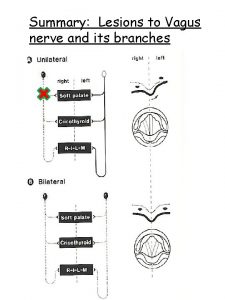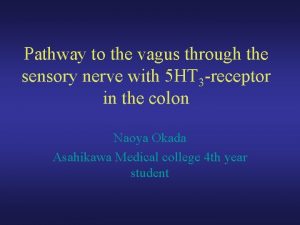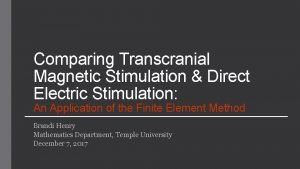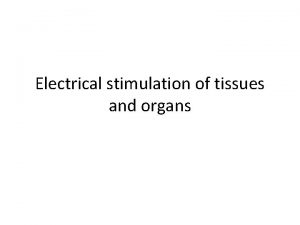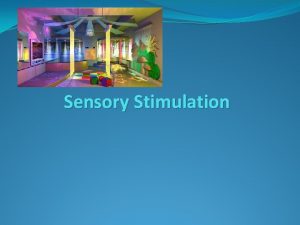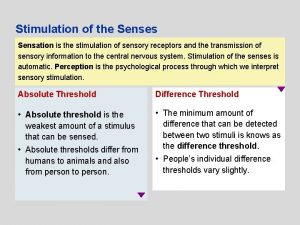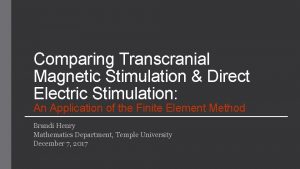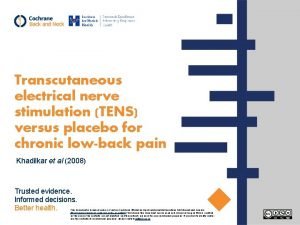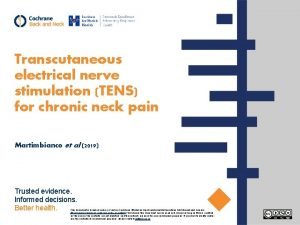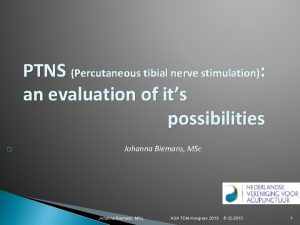Vagus nerve stimulation Recent Case Vagus nerve stimulation







































































































































- Slides: 135

Vagus nerve stimulation Recent Case Vagus nerve stimulation is a procedure that involves implantation of a device that stimulates the vagus nerve with electrical impulses. It is most often used to treat epilepsy when other treatments haven't worked. In conventional vagus nerve stimulation, a device is surgically implanted under the skin on your chest, and a wire is threaded under your skin connecting the device to the left vagus nerve. The right vagus nerve is not used because it carries fibers that supply nerves to the heart. When activated, the device sends electrical signals along the vagus nerve to your brainstem, which then sends signals to certain areas in your brain. https: //www. epilepsy. com/learn/treating-seizures-andepilepsy/devices/vagus-nerve-stimulation-vns © 2015 Pearson Education, Inc.

© 2015 Pearson Education, Inc.

Restoring consciousness with vagus nerve stimulation Martina Corazzol et al Current Biology. Volume 27, Issue 18, p. R 994–R 996, 25 September 2017 Patients lying in a vegetative state present severe impairments of consciousness [1] caused by lesions in the cortex, the brainstem, the thalamus and the white matter [2]. There is agreement that this condition may involve disconnections in long-range cortico–cortical and thalamocortical pathways [3]. Hence, in the vegetative state cortical activity is ‘deafferented’ from subcortical modulation and/or principally disrupted between fronto-parietal regions. Some patients in a vegetative state recover while others persistently remain in such a state. The neural signature of spontaneous recovery is linked to increased thalamo-cortical activity and improved fronto-parietal functional connectivity [3]. The likelihood of consciousness recovery depends on the extent of brain damage and patients’ etiology, but after one year of unresponsive behavior, chances become low [1]. There is thus a need to explore novel ways of repairing lost consciousness. Here we report beneficial effects of vagus nerve stimulation on consciousness level of a single patient in a vegetative state, including improved behavioral responsiveness and enhanced brain connectivity patterns. © 2015 Pearson Education, Inc.

An Introduction to the ANS and Higher. Order Functions • Somatic Nervous System (SNS) • Operates under conscious control • Seldom affects long-term survival • SNS controls skeletal muscles • Autonomic Nervous System (ANS) • Operates without conscious instruction • ANS controls visceral effectors • Coordinates system functions • Cardiovascular, respiratory, digestive, urinary, reproductive © 2015 Pearson Education, Inc.

Figure 16 -1 a The Organization of the Somatic and Autonomic Nervous Systems. Upper motor neurons in primary motor cortex Brain Somatic motor nuclei of brain stem Skeletal muscle Lower motor neurons Spinal cord Somatic motor nuclei of spinal cord Skeletal muscle a Somatic nervous system © 2015 Pearson Education, Inc.

Figure 16 -1 b The Organization of the Somatic and Autonomic Nervous Systems. Visceral motor nuclei in hypothalamus Brain Preganglionic neuron Visceral Effectors Smooth muscle Autonomic ganglia Glands Cardiac muscle Ganglionic neurons Adipocytes Preganglionic neuron © 2015 Pearson Education, Inc. b Autonomic nuclei in brain stem Spinal cord Autonomic nuclei in spinal cord Autonomic nervous system

16 -1 Divisions of the ANS • The Autonomic Nervous System • Operates largely outside our awareness • Has two divisions 1. Sympathetic division • Increases alertness, metabolic rate, and muscular abilities 2. Parasympathetic division • Reduces metabolic rate and promotes digestion © 2015 Pearson Education, Inc.

16 -1 Divisions of the ANS • Sympathetic Division • Kicks in only during exertion, stress, or emergency • “Fight or flight” • Parasympathetic Division • Controls during resting conditions • “Rest and digest” © 2015 Pearson Education, Inc.

16 -1 Divisions of the ANS • Sympathetic and Parasympathetic Division 1. Most often, these two divisions have opposing effects • If the sympathetic division causes excitation, the parasympathetic causes inhibition 2. The two divisions may also work independently • Only one division innervates some structures 3. The two divisions may work together, with each controlling one stage of a complex process © 2015 Pearson Education, Inc.

16 -1 Divisions of the ANS • Sympathetic Division • Preganglionic fibers (thoracic and superior lumbar; thoracolumbar) synapse in ganglia near spinal cord • Preganglionic fibers are short • Postganglionic fibers are long • Prepares body for crisis, producing a “fight or flight” response • Stimulates tissue metabolism • Increases alertness © 2015 Pearson Education, Inc.

16 -1 Divisions of the ANS • Seven Responses to Increased Sympathetic Activity 1. 2. 3. 4. 5. Heightened mental alertness Increased metabolic rate Reduced digestive and urinary functions Energy reserves activated Increased respiratory rate and respiratory passageways dilate 6. Increased heart rate and blood pressure 7. Sweat glands activated © 2015 Pearson Education, Inc.

16 -1 Divisions of the ANS • Parasympathetic Division • Preganglionic fibers originate in brain stem and sacral segments of spinal cord; craniosacral • Synapse in ganglia close to (or within) target organs • Preganglionic fibers are long • Postganglionic fibers are short • Parasympathetic division stimulates visceral activity • Conserves energy and promotes sedentary activities © 2015 Pearson Education, Inc.

16 -1 Divisions of the ANS • Five Responses to Increased Parasympathetic Activity 1. Decreased metabolic rate 2. Decreased heart rate and blood pressure 3. Increased secretion by salivary and digestive glands 4. Increased motility and blood flow in digestive tract 5. Urination and defecation stimulation © 2015 Pearson Education, Inc.

Figure 16 -2 Overview of the Autonomic Nervous System (Part 1 of 2). Sympathetic Division (Thoracolumbar) Preganglionic Neurons Preganglionic neurons are located in the lateral gray horns of spinal segments T 1–L 2. Ganglia are located near the spinal cord. Preganglionic fibers release acetylcholine (Ach), stimulating ganglionic neurons. Target Organs Most postganglionic fibers release norepinephrine (NE) at neuroeffector junctions. Sympathetic activation “Fight or flight” response KEY Preganglionic fibers Postganglionic fibers © 2015 Pearson Education, Inc.

Figure 16 -2 Overview of the Autonomic Nervous System (Part 2 of 2). Parasympathetic Division (Craniosacral) Preganglionic Neurons Preganglionic neurons in brain stem and in lateral portion of anterior gray horns of S 2–S 4. Ganglia are in or near the target organ. Preganglionic fibers release acetylcholine (Ach), stimulating ganglionic neurons. Target Organs All postganglionic fibers release Ach at neuroeffector junctions. Parasympathetic stimulation “Rest and digest” response KEY Preganglionic fibers Postganglionic fibers © 2015 Pearson Education, Inc.

Cigarette Smoking/Addiction: After absorption, nicotine travels rapidly and reaches the brain within seven seconds; it readily crosses the blood–brain barrier. This sudden burst of nicotine in the brain causes elevation of blood pressure due to stimulation of adrenal glands resulting in discharge of epinephrine. There is also sudden release of glucose and increase in respiration, heart rate, constriction of arteries and increased alertness. Many of these effects are produced through its action on both the peripheral and central nervous system. Nicotine causes release of dopamine, therefore, the psycho-active rewards occur quickly and these rewards are highly reinforced. Nicotine is distributed throughout the body, mostly to skeletal muscles and brain and activates specific receptors known as cholinergic receptors. © 2015 Pearson Education, Inc.

16 -1 Divisions of the ANS • Enteric Nervous System (ENS) • • • Third division of ANS Extensive network in digestive tract walls Complex visceral reflexes coordinated locally Roughly 100 million neurons All neurotransmitters are found in the brain Can be damages by ischemia © 2015 Pearson Education, Inc.

16 -2 The Sympathetic Division • Ganglionic Neurons • Occur in three locations 1. Sympathetic chain ganglia 2. Collateral ganglia 3. Adrenal medullae © 2015 Pearson Education, Inc.

Figure 16 -3 a Sites of Ganglia in Sympathetic Pathways. a SYMPATHETIC CHAIN GANGLIA Spinal nerve Preganglionic neuron Autonomic ganglion of left sympathetic chain Autonomic ganglion of right sympathetic chain Innervates visceral effectors by spinal nerves White ramus Sympathetic nerve (postganglionic fibers) Innervates visceral organs in thoracic cavity by sympathetic nerves Note: Both innervation patterns occur on each side of the body. © 2015 Pearson Education, Inc. Ganglionic neuron Gray ramus KEY Preganglionic neurons Ganglionic neurons

16 -2 The Sympathetic Division • Collateral Ganglia • Are anterior to vertebral bodies • Contain ganglionic neurons that innervate tissues and organs in abdominopelvic cavity © 2015 Pearson Education, Inc.

Figure 16 -3 b Sites of Ganglia in Sympathetic Pathways. COLLATERAL GANGLIA b Lateral gray horn White ramus Splanchnic nerve (preganglionic fibers) Postganglionic fibers © 2015 Pearson Education, Inc. Collateral ganglion Innervates visceral organs in abdominopelvic cavity

16 -2 The Sympathetic Division • Adrenal Medullae (Suprarenal Medullae) • Very short axons • When stimulated, release neurotransmitters into bloodstream (not at synapse) • Function as hormones to affect target cells throughout body © 2015 Pearson Education, Inc.

Figure 16 -3 c Sites of Ganglia in Sympathetic Pathways. c Preganglionic fibers Endocrine cells (specialized ganglionic neurons) © 2015 Pearson Education, Inc. THE ADRENAL MEDULLAE Adrenal medullae Secretes neurotransmitters into general circulation

16 -2 The Sympathetic Division • Fibers in Sympathetic Division • Preganglionic fibers • Are relatively short • Ganglia located near spinal cord • Postganglionic fibers • Are relatively long, except at adrenal medullae © 2015 Pearson Education, Inc.

Figure 16 -4 The Distribution of Sympathetic Innervation (Part 2 of 4). Eye Pons Salivary glands Sympathetic nerves Heart Cardiac and pulmonary plexuses T 1 T 2 T 3 T 4 KEY Preganglionic fibers Postganglionic fibers © 2015 Pearson Education, Inc. Lung

Figure 16 -4 The Distribution of Sympathetic Innervation (Part 3 of 4). T 1 T 2 T 3 T 4 T 5 T 6 T 7 Greater splanchnic nerve KEY Preganglionic fibers Celiac ganglion Postganglionic fibers Superior mesenteric ganglion Liver and gallbladder T 8 T 9 T 10 T 11 T 12 L 1 L 2 L 3 L 4 L 5 S 1 S 2 S 3 S 4 Stomach Lesser splanchnic nerve Spleen Pancreas Large intestine Lumbar splanchnic nerves Small intestine Inferior mesenteric ganglion Adrenal medulla Sacral splanchnic nerves Kidney S 5 Coccygeal ganglia (Co 1) fused together (ganglion impar) © 2015 Pearson Education, Inc. Uterus Ovary Penis Scrotum Urinary bladder

Figure 16 -4 The Distribution of Sympathetic Innervation (Part 3 of 4). T 1 T 2 T 3 T 4 T 5 T 6 T 7 Greater splanchnic nerve KEY Preganglionic fibers Celiac ganglion Postganglionic fibers Superior mesenteric ganglion Liver and gallbladder T 8 T 9 T 10 T 11 T 12 L 1 L 2 L 3 L 4 L 5 S 1 S 2 S 3 S 4 Stomach Lesser splanchnic nerve Spleen Pancreas Large intestine Lumbar splanchnic nerves Small intestine Inferior mesenteric ganglion Adrenal medulla Sacral splanchnic nerves Kidney S 5 Coccygeal ganglia (Co 1) fused together (ganglion impar) © 2015 Pearson Education, Inc. Uterus Ovary Penis Scrotum Urinary bladder

16 -2 The Sympathetic Division • Adrenal Medullae • Preganglionic fibers entering adrenal gland proceed to center (adrenal medulla) • Modified sympathetic ganglion • Preganglionic fibers synapse on neuroendocrine cells • Specialized neurons secrete hormones into bloodstream © 2015 Pearson Education, Inc.

16 -2 The Sympathetic Division • Adrenal Medullae • Neuroendocrine cells • Secrete neurotransmitters epinephrine (E) and norepinephrine (NE) • Epinephrine • Also called adrenaline • Is 75– 80 percent of secretory output • Remaining is norepinephrine (NE) • Noradrenaline © 2015 Pearson Education, Inc.

Figure 16 -7 Summary: The Anatomical Differences between the Sympathetic and Parasympathetic Divisions. Sympathetic CNS Parasympathetic Preganglionic neuron PNS Preganglionic fiber Sympathetic ganglion KEY Neurotransmitters Acetylcholine Norepinephrine or Epinephrine Ganglionic neurons Bloodstream Postganglionic fiber TARGET © 2015 Pearson Education, Inc. Parasympathetic ganglion

16 -3 Various Sympathetic Neurotransmitters • Sympathetic Stimulation and the Release of NE and E • Primarily from interactions of NE and E with two types of adrenergic membrane receptors 1. Alpha receptors (NE more potent) 2. Beta receptors • Activates enzymes on inside of cell membrane via G proteins © 2015 Pearson Education, Inc.

16 -3 Various Sympathetic Neurotransmitters • Sympathetic Stimulation and the Release of NE and E • Alpha-1 ( 1) • More common type of alpha receptor • Releases intracellular calcium ions from reserves in endoplasmic reticulum • Has excitatory effect on target cell © 2015 Pearson Education, Inc.

16 -3 Various Sympathetic Neurotransmitters • Sympathetic Stimulation and the Release of NE and E • Alpha-2 ( 2) • Lowers c. AMP levels in cytoplasm • Has inhibitory effect on the cell • Helps coordinate sympathetic and parasympathetic activities © 2015 Pearson Education, Inc.

16 -3 Various Sympathetic Neurotransmitters • Sympathetic Stimulation and the Release of NE and E • Beta ( ) receptors • Affect membranes in many organs (skeletal muscles, lungs, heart, and liver) • Trigger metabolic changes in target cell • Stimulation increases intracellular c. AMP levels (derivative of ATP used as second messenger for intracellular signaling). © 2015 Pearson Education, Inc.

16 -3 Various Sympathetic Neurotransmitters • Three Main Types of Beta Receptors 1. Beta-1 ( 1) • Increases metabolic activity 2. Beta-2 ( 2) • Triggers relaxation of smooth muscles along respiratory tract 3. Beta-3 ( 3) • Leads to lipolysis, the breakdown of triglycerides in adipocytes © 2015 Pearson Education, Inc.

16 -3 Various Sympathetic Neurotransmitters • Sympathetic Stimulation and the Release of ACh and NO • Cholinergic (ACh) sympathetic terminals • Innervate sweat glands of skin and blood vessels of skeletal muscles and brain • Stimulate sweat gland secretion and dilate blood vessels © 2015 Pearson Education, Inc.

16 -3 Various Sympathetic Neurotransmitters • Sympathetic Stimulation and the Release of ACh and NO • Nitroxidergic synapses • Release nitric oxide (NO) as neurotransmitter • Neurons innervate smooth muscles in walls of blood vessels in skeletal muscles and the brain • Produce vasodilation and increased blood flow © 2015 Pearson Education, Inc.

16 -4 The Parasympathetic Division • Autonomic Nuclei • Are contained in the mesencephalon, pons, and medulla oblongata • Associated with cranial nerves III, VII, IX, X • In lateral gray horns of spinal segments S 2–S 4 © 2015 Pearson Education, Inc.

Figure 16 -6 The Distribution of Parasympathetic Innervation (Part 1 of 2). Pterygopalatine ganglion N III Lacrimal gland Eye Ciliary ganglion Pons N VII N IX Submandibular ganglion Salivary glands Otic ganglion N X (Vagus) Heart Lungs © 2015 Pearson Education, Inc.

Figure 16 -6 The Distribution of Parasympathetic Innervation (Part 2 of 2). Lungs Autonomic plexuses (see Figure 16 -8) Liver and gallbladder Stomach Spleen Pancreas Large intestine Pelvic nerves Small intestine Rectum Spinal cord Kidney S 2 S 3 S 4 KEY Preganglionic fibers Postganglionic fibers © 2015 Pearson Education, Inc. Uterus Ovary Penis Scrotum Urinary bladder

16 -5 Parasympathetic Neurons Release ACh • Neuromuscular and Neuroglandular Junctions • All release ACh as neurotransmitter • Small, with narrow synaptic clefts • Effects of stimulation are short lived • Inactivated by acetylcholinesterase (ACh. E) at synapse • ACh is also inactivated by tissue cholinesterase in surrounding tissues © 2015 Pearson Education, Inc.

16 -5 Parasympathetic Neurons Release ACh • Membrane Receptors and Responses • Nicotinic receptors • On surfaces of ganglion cells (sympathetic and parasympathetic) • Exposure to ACh causes excitation of ganglionic neuron or muscle fiber • Studies suggest that the alpha-4 beta-2 nicotine acetylcholine receptor subtype is the main receptor that mediates nicotine dependence. Nicotine acts on these receptors to facilitate neurotransmitter release (dopamine and others), producing pleasure and mood modulation. © 2015 Pearson Education, Inc.

16 -5 Parasympathetic Neurons Release ACh • Membrane Receptors and Responses • Muscarinic receptors • At cholinergic neuromuscular or neuroglandular junctions (parasympathetic) • At few cholinergic junctions (sympathetic) • G proteins • Effects are longer lasting than nicotinic receptors • Response reflects activation or inactivation of specific enzymes • Can be excitatory or inhibitory © 2015 Pearson Education, Inc.

16 -5 Parasympathetic Neurons Release ACh • Dangerous Environmental Toxins • Produce exaggerated, uncontrolled responses • Nicotine • Binds to nicotinic receptors • Targets autonomic ganglia and skeletal neuromuscular junctions • 50 mg ingested or absorbed through skin • Signs and symptoms: • Vomiting, diarrhea, high blood pressure, rapid heart rate, sweating, profuse salivation, convulsions • May result in coma or death © 2015 Pearson Education, Inc.

16 -5 Parasympathetic Neurons Release ACh • Dangerous Environmental Toxins • Produce exaggerated, uncontrolled responses • Muscarine • Binds to muscarinic receptors • Targets parasympathetic neuromuscular or neuroglandular junctions • Signs and symptoms: • Salivation, nausea, vomiting, diarrhea, constriction of respiratory passages, low blood pressure, slow heart rate (bradycardia) © 2015 Pearson Education, Inc.

Table 16 -1 Adrenergic and Cholinergic Receptors of the ANS. © 2015 Pearson Education, Inc.

© 2015 Pearson Education, Inc.

16 -6 Dual Innervation • Sympathetic Division • Widespread impact • Reaches organs and tissues throughout body • Parasympathetic Division • Innervates only specific visceral structures • Sympathetic and Parasympathetic Division • Most vital organs receive instructions from both sympathetic and parasympathetic divisions • Two divisions commonly have opposing effects © 2015 Pearson Education, Inc.

16 -6 Dual Innervation • Anatomy of Dual Innervation • Parasympathetic postganglionic fibers accompany cranial nerves to peripheral destinations • Sympathetic innervation reaches same structures • By traveling directly from superior cervical ganglia of sympathetic chain © 2015 Pearson Education, Inc.

Figure 16 -7 Summary: The Anatomical Differences between the Sympathetic and Parasympathetic Divisions. Sympathetic CNS Parasympathetic Preganglionic neuron PNS Preganglionic fiber Sympathetic ganglion KEY Neurotransmitters Acetylcholine Norepinephrine or Epinephrine Ganglionic neurons Bloodstream Postganglionic fiber TARGET © 2015 Pearson Education, Inc. Parasympathetic ganglion

Table 16 -2 A Structural Comparison of the Sympathetic and Parasympathetic Divisions of the ANS. © 2015 Pearson Education, Inc.

Table 16 -3 A Functional Comparison of the Sympathetic and Parasympathetic Divisions of the ANS (Part 1 of 4). © 2015 Pearson Education, Inc.

Table 16 -3 A Functional Comparison of the Sympathetic and Parasympathetic Divisions of the ANS (Part 2 of 4). © 2015 Pearson Education, Inc.

Table 16 -3 A Functional Comparison of the Sympathetic and Parasympathetic Divisions of the ANS (Part 3 of 4). © 2015 Pearson Education, Inc.

Table 16 -3 A Functional Comparison of the Sympathetic and Parasympathetic Divisions of the ANS (Part 4 of 4). © 2015 Pearson Education, Inc.

16 -6 Dual Innervation • Anatomy of Dual Innervation • Autonomic plexuses • Nerve networks in the thoracic and abdominopelvic cavities • Are formed by mingled sympathetic postganglionic fibers and parasympathetic preganglionic fibers • Travel with blood and lymphatic vessels that supply visceral organs © 2015 Pearson Education, Inc.

16 -6 Dual Innervation • Anatomy of Dual Innervation • • • Cardiac plexus Pulmonary plexus Esophageal plexus Celiac plexus Inferior mesenteric plexus Hypogastric plexus © 2015 Pearson Education, Inc.

16 -6 Dual Innervation • Cardiac and Pulmonary Plexuses • Autonomic fibers entering thoracic cavity intersect • Contain: • Sympathetic and parasympathetic fibers for heart and lungs • Parasympathetic ganglia whose output affects those organs © 2015 Pearson Education, Inc.

16 -6 Dual Innervation • Esophageal Plexus • Contains: • Descending branches of vagus nerves • Splanchnic nerves leaving sympathetic chain • Parasympathetic preganglionic fibers of vagus nerve enter abdominopelvic cavity with esophagus • Fibers enter celiac plexus (solar plexus) © 2015 Pearson Education, Inc.

Figure 16 -8 The Autonomic Plexuses and Ganglia (Part 1 of 2). Aortic arch Right vagus nerve Autonomic Plexuses and Ganglia Cardiac plexus Pulmonary plexus Thoracic sympathetic chain ganglia Esophageal plexus Celiac plexus and ganglion Superior mesenteric ganglion Inferior mesenteric plexus and ganglia Hypogastric plexus Pelvic sympathetic chain © 2015 Pearson Education, Inc.

16 -6 Dual Innervation • Celiac Plexus • Associated with smaller plexuses, such as inferior mesenteric plexus • Innervates viscera within abdominal cavity © 2015 Pearson Education, Inc.

16 -6 Dual Innervation • Hypogastric Plexus • Contains: • Parasympathetic outflow of pelvic nerves • Sympathetic postganglionic fibers from inferior mesenteric ganglion • Splanchnic nerves from sacral sympathetic chain • Innervates digestive, urinary, and reproductive organs of pelvic cavity © 2015 Pearson Education, Inc.

Figure 16 -8 The Autonomic Plexuses and Ganglia (Part 2 of 2). Trachea Left vagus nerve Thoracic spinal nerves Esophagus Splanchnic nerves Diaphragm Superior mesenteric artery Inferior mesenteric artery © 2015 Pearson Education, Inc.

16 -6 Dual Innervation • Autonomic Tone • Is an important aspect of ANS function • If nerve is inactive under normal conditions, can only increase activity • If nerve maintains background level of activity, can increase or decrease activity © 2015 Pearson Education, Inc.

16 -6 Dual Innervation • Autonomic Tone • Autonomic motor neurons • Maintain resting level of spontaneous activity • Background level of activation determines autonomic tone © 2015 Pearson Education, Inc.

16 -6 Dual Innervation • Autonomic Tone • Significant where dual innervation occurs • Two divisions have opposing effects • More important when dual innervation does not occur © 2015 Pearson Education, Inc.

16 -6 Dual Innervation • The Heart Receives Dual Innervation • Two divisions have opposing effects on heart function 1. Parasympathetic division • Acetylcholine released by postganglionic fibers slows heart rate 2. Sympathetic division • NE released by varicosities accelerates heart rate • Balance between two divisions • Autonomic tone is present • Releases small amounts of both neurotransmitters continuously © 2015 Pearson Education, Inc.

16 -6 Dual Innervation • The Heart Receives Dual Innervation • Parasympathetic innervation dominates under resting conditions • Crisis accelerates heart rate by: • Stimulation of sympathetic innervation • Inhibition of parasympathetic innervation © 2015 Pearson Education, Inc.

16 -6 Dual Innervation • Autonomic Tone • Blood vessel dilates and blood flow increases • Blood vessel constricts and blood flow is reduced • Sympathetic postganglionic fibers release NE • Innervate smooth muscle cells in walls of peripheral vessels © 2015 Pearson Education, Inc.

16 -6 Dual Innervation • Autonomic Tone • Background sympathetic tone keeps muscles partially contracted • To increase blood flow: • • Rate of NE release decreases Sympathetic cholinergic fibers are stimulated Smooth muscle cells relax Vessels dilate and blood flow increases © 2015 Pearson Education, Inc.

16 -7 Visceral Reflexes Regulate the ANS • Somatic Motor Control • Centers in all portions of CNS • Lowest level regulatory control • Lower motor neurons of cranial and spinal visceral reflex arcs • Highest level • Pyramidal motor neurons of primary motor cortex • Operating with feedback from cerebellum and basal nuclei © 2015 Pearson Education, Inc.

16 -7 Visceral Reflexes Regulate the ANS • Visceral Reflexes • Provide automatic motor responses • Can be modified, facilitated, or inhibited by higher centers, especially hypothalamus • Visceral reflex arc • Receptor • Sensory neuron • Processing center (one or more interneurons) • All polysynaptic • Two visceral motor neurons © 2015 Pearson Education, Inc.

16 -7 Visceral Reflexes Regulate the ANS • Visceral Reflexes • Long reflexes • Autonomic equivalents of polysynaptic reflexes • Visceral sensory neurons deliver information to CNS along dorsal roots of spinal nerves • Within sensory branches of cranial nerves • Within autonomic nerves that innervate visceral effectors • ANS carries motor commands to visceral effectors • Coordinate activities of entire organ © 2015 Pearson Education, Inc.

16 -7 Visceral Reflexes Regulate the ANS • Visceral Reflexes • Short reflexes • Bypass CNS • Involve sensory neurons and interneurons located within autonomic ganglia • Interneurons synapse on ganglionic neurons • Motor commands distributed by postganglionic fibers • Control simple motor responses with localized effects • One small part of target organ © 2015 Pearson Education, Inc.

Figure 16 -9 Visceral Reflexes. Receptors in peripheral tissue Afferent (sensory) fibers CENTRAL NERVOUS SYSTEM Stimulus Long reflex Short reflex Processing center in spinal cord Response Peripheral effector Postganglionic neuron © 2015 Pearson Education, Inc. Autonomic ganglion Preganglionic (sympathetic or neuron parasympathetic)

16 -7 Visceral Reflexes Regulate the ANS • Visceral Reflexes • Regulating visceral activity • Most organs • Long reflexes most important • Digestive tract • Short reflexes provide most control and coordination © 2015 Pearson Education, Inc.

16 -7 Visceral Reflexes Regulate the ANS • Visceral Reflexes • Enteric nervous system • Ganglia in the walls of digestive tract contain cell bodies of: • Visceral sensory neurons • Interneurons • Visceral motor neurons • Axons form extensive nerve nets • Control digestive functions independent of CNS © 2015 Pearson Education, Inc.

Table 16 -4 Representative Visceral Reflexes (Part 1 of 2). © 2015 Pearson Education, Inc.

Table 16 -4 Representative Visceral Reflexes (Part 2 of 2). © 2015 Pearson Education, Inc.

16 -7 Visceral Reflexes Regulate the ANS • Higher Levels of Autonomic Control • Simple reflexes from spinal cord provide rapid and automatic responses • Complex reflexes coordinated in medulla oblongata • Contains centers and nuclei involved in: • • • Salivation Swallowing Digestive secretions Peristalsis Urinary function • Regulated by hypothalamus © 2015 Pearson Education, Inc.

16 -7 Visceral Reflexes Regulate the ANS • The Integration of SNS and ANS Activities • Many parallels in organization and function • Integration at brain stem • Both systems under control of higher centers © 2015 Pearson Education, Inc.

Figure 16 -10 A Comparison of Somatic and Autonomic Function. Central Nervous System Cerebral cortex Limbic system Thalamus Hypothalamus Somatic sensory Visceral sensory Relay and processing centers in brain stem Long reflexes Somatic reflexes Peripheral Nervous System Lower motor neuron SNS Sensory pathways Preganglionic neuron ANS Short reflexes Ganglionic neuron Skeletal muscles © 2015 Pearson Education, Inc. Sensory receptors Visceral effectors

Table 16 -5 A Comparison of the ANS and SNS. © 2015 Pearson Education, Inc.

16 -8 Higher-Order Functions • Higher-Order Functions Share Three Characteristics 1. Require the cerebral cortex 2. Involve conscious and unconscious information processing 3. Are not part of programmed “wiring” of brain • Can adjust over time © 2015 Pearson Education, Inc.

16 -8 Higher-Order Functions • Memory • Fact memories • Are specific bits of information • Skill memories • Learned motor behaviors • Incorporated at unconscious level with repetition • Programmed behaviors stored in appropriate area of brain stem • Complex skill memories are stored and involve motor patterns in the basal nuclei, cerebral cortex, and cerebellum © 2015 Pearson Education, Inc.

16 -8 Higher-Order Functions • Memory • Short-term memories • Information that can be recalled immediately • Contain small bits of information • Primary memories © 2015 Pearson Education, Inc.

16 -8 Higher-Order Functions • Memory • Long-term memories • Memory consolidation – conversion from shortterm to long-term memory • Two types of long-term memory 1. Secondary memories fade and require effort to recall 2. Tertiary memories are with you for life © 2015 Pearson Education, Inc.

Figure 16 -11 Memory Storage. Repetition promotes retention Sensory input Short-Term Memory Long-Term Memory Consolidation Secondary Memory Tertiary Memory • Cerebral cortex (fact memory) • Cerebral cortex and cerebellar cortex (skill memory) Temporary loss Permanent loss due to neural fatigue, shock, interference by other stimuli © 2015 Pearson Education, Inc. Permanent loss

16 -8 Higher-Order Functions • Brain Regions Involved in Memory Consolidation and Access • Amygdaloid body and hippocampus • Nucleus basalis • Cerebral cortex © 2015 Pearson Education, Inc.

16 -8 Higher-Order Functions • Amygdaloid Body and Hippocampus • Are essential to memory consolidation • Damage may cause: • Inability to convert short-term memories to new long-term memories • Existing long-term memories remain intact and accessible © 2015 Pearson Education, Inc.

16 -8 Higher-Order Functions • Nucleus Basalis • Cerebral nucleus near diencephalon • Plays uncertain role in memory storage and retrieval • Tracts connect with hippocampus, amygdaloid body, and cerebral cortex • Damage changes emotional states, memory, and intellectual functions © 2015 Pearson Education, Inc.

16 -8 Higher-Order Functions • Cerebral Cortex • Stores long-term memories • Conscious motor and sensory memories referred to association areas • Occipital and temporal lobes • Special portions crucial to memories of faces, voices, and words • A specific neuron may be activated by combination of sensory stimuli associated with particular individual; called “grandmother cells” © 2015 Pearson Education, Inc.

16 -8 Higher-Order Functions • Cerebral Cortex • • • Visual association area Auditory association area Speech center Frontal lobes Related information stored in other locations • If storage area is damaged, memory will be incomplete © 2015 Pearson Education, Inc.

16 -8 Higher-Order Functions • Cellular Mechanisms of Memory Formation and Storage • Involves anatomical and physiological changes in neurons and synapses • Increased neurotransmitter release • Facilitation at synapses • Formation of additional synaptic connections © 2015 Pearson Education, Inc.

16 -8 Higher-Order Functions • Increased Neurotransmitter Release • Frequently active synapse increases the amount of neurotransmitter it stores • Releases more on each stimulation • The more neurotransmitter released, the greater effect on postsynaptic neuron © 2015 Pearson Education, Inc.

16 -8 Higher-Order Functions • Facilitation at Synapses • Neural circuit repeatedly activated • Synaptic terminals begin continuously releasing neurotransmitter • Neurotransmitter binds to receptors on postsynaptic membrane • Produces graded depolarization • Brings membrane closer to threshold • Facilitation results affect all neurons in circuit © 2015 Pearson Education, Inc.

16 -8 Higher-Order Functions • Formation of Additional Synaptic Connections • Neurons repeatedly communicating • Axon tip branches and forms additional synapses on postsynaptic neuron • Presynaptic neuron has greater effect on transmembrane potential of postsynaptic neuron © 2015 Pearson Education, Inc.

16 -8 Higher-Order Functions • Cellular Mechanisms of Memory Formation and Storage • Basis of memory storage • Processes create anatomical changes • Facilitate communication along specific neural circuit • Memory Engram • Single circuit corresponds to single memory • Forms as result of experience and repetition © 2015 Pearson Education, Inc.

16 -8 Higher-Order Functions • Cellular Mechanisms of Memory Formation and Storage • Efficient conversion of short-term memory • Takes at least 1 hour • Repetition crucial • Factors of conversion • Nature, intensity, and frequency of original stimulus • Strong, repeated, and exceedingly pleasant or unpleasant events likely converted to long-term memories © 2015 Pearson Education, Inc.

16 -8 Higher-Order Functions • Cellular Mechanisms of Memory Formation and Storage • Drugs stimulate CNS • Caffeine and nicotine are examples • Enhance memory consolidation through facilitation © 2015 Pearson Education, Inc.

16 -8 Higher-Order Functions • Cellular Mechanisms of Memory Formation and Storage • Drugs stimulate CNS • NMDA (N-methyl D-aspartate) Receptors • • • © 2015 Pearson Education, Inc. Linked to consolidation Chemically gated calcium channels Activated by neurotransmitter glutamate Gates open, calcium enters cell Blocking NMDA receptors in hippocampus prevents long-term memory formation

16 -8 Higher-Order Functions • States of Consciousness • Many gradations of states • Degree of wakefulness indicates level of ongoing CNS activity • When abnormal or depressed, state of wakefulness is affected © 2015 Pearson Education, Inc.

16 -8 Higher-Order Functions • States of Consciousness • Deep sleep • • Also called slow-wave or Non-REM (NREM) sleep Entire body relaxes Cerebral cortex activity minimal Heart rate, blood pressure, respiratory rate, and energy utilization decline up to 30 percent © 2015 Pearson Education, Inc.

16 -8 Higher-Order Functions • States of Consciousness • Rapid eye movement (REM) sleep • • • Active dreaming occurs Changes in blood pressure and respiratory rate Less receptive to outside stimuli than in deep sleep Muscle tone decreases markedly Intense inhibition of somatic motor neurons Eyes move rapidly as dream events unfold © 2015 Pearson Education, Inc.

16 -8 Higher-Order Functions • States of Consciousness • Nighttime sleep pattern • Alternates between levels • Begins in deep sleep • REM periods average 5 minutes in length; increase to 20 minutes over 8 hours © 2015 Pearson Education, Inc.

16 -8 Higher-Order Functions • Sleep • Has important impact on CNS • Produces only minor changes in physiological activities of organs and systems • Protein synthesis in neurons increases during sleep • Extended periods without sleep lead to disturbances in mental function • 25 percent of the U. S. population experiences sleep disorders © 2015 Pearson Education, Inc.

Figure 16 -12 a States of Sleep. Awake REM sleep Deep (slow wave) sleep a An EEG of the various sleep states. The EEG pattern during REM sleep resembles the alpha waves typical of awake adults. © 2015 Pearson Education, Inc.

Figure 16 -12 b States of Sleep. Awake REM sleep Transition period Deep sleep 10: 00 P. M. Midnight 2: 00 A. M. 4: 00 A. M. 6: 00 A. M. Time b Typical pattern of sleep stages in a healthy young adult during a single night’s sleep. © 2015 Pearson Education, Inc.

16 -8 Higher-Order Functions • States of Consciousness • Arousal and the reticular activating system (RAS) • Awakening from sleep • Function of reticular formation • Extensive interconnections with sensory, motor, integrative nuclei, and pathways along brain stem • Determined by complex interactions between reticular formation and cerebral cortex © 2015 Pearson Education, Inc.

16 -8 Higher-Order Functions • Reticular Activating System (RAS) • • Important brain stem component Diffuse network in reticular formation Extends from medulla oblongata to midbrain Output of RAS projects to thalamic nuclei that influence large areas of cerebral cortex • When RAS inactive, so is cerebral cortex • Stimulation of RAS produces widespread activation of cerebral cortex © 2015 Pearson Education, Inc.

16 -8 Higher-Order Functions • Arousal and the Reticular Activating System • Ending sleep • Any stimulus activates reticular formation and RAS • Arousal occurs rapidly • Effects of single stimulation of RAS last less than a minute © 2015 Pearson Education, Inc.

16 -8 Higher-Order Functions • Arousal and the Reticular Activating System • Maintaining consciousness • Activity in cerebral cortex, basal nuclei, and sensory and motor pathways continue to stimulate RAS • After many hours, reticular formation becomes less responsive to stimulation • Individual becomes less alert and more lethargic • Neural fatigue reduces RAS activity © 2015 Pearson Education, Inc.

16 -8 Higher-Order Functions • Arousal and the Reticular Activating System • Regulation of sleep–wake cycles • Involves interplay between brain stem nuclei that use different neurotransmitters • Group of nuclei stimulates RAS with NE and maintains awake, alert state • Other group promotes deep sleep by depressing RAS activity with serotonin • “Dueling” nuclei located in brain stem © 2015 Pearson Education, Inc.

Figure 16 -13 The Reticular Activating System. RAS N II Special sensory input III V N Reticular formation General cranial or spinal nerve input © 2015 Pearson Education, Inc.

16 -9 Brain Chemistry • Changes in normal balance between two or more neurotransmitters can profoundly affect brain function © 2015 Pearson Education, Inc.

16 -9 Brain Chemistry • Huntington’s Disease • Destruction of ACh-secreting and GABA-secreting neurons in basal nuclei • Symptoms appear as basal nuclei and frontal lobes slowly degenerate • Difficulty controlling movements • Intellectual abilities gradually decline © 2015 Pearson Education, Inc.

16 -9 Brain Chemistry • Lysergic Acid Diethylamide (LSD) • Powerful hallucinogenic drug • Activates serotonin receptors in brain stem, hypothalamus, and limbic system © 2015 Pearson Education, Inc.

16 -9 Brain Chemistry • Serotonin • Compounds that enhance effects also produce hallucinations (LSD) • Compounds that inhibit or block action cause severe depression and anxiety • Variations in levels affect sensory interpretation and emotional states © 2015 Pearson Education, Inc.

16 -9 Brain Chemistry • Serotonin • Fluoxetine (Prozac) • Slows removal of serotonin at synapses • Increases serotonin concentrations at postsynaptic membrane • Classified as selective serotonin reuptake inhibitors (SSRIs) • Other SSRIs • Celexa, Luvox, Paxil, and Zoloft © 2015 Pearson Education, Inc.

16 -9 Brain Chemistry • Parkinson’s Disease • Inadequate dopamine production causes motor problems • Dopamine • Secretion stimulated by amphetamines, or “speed” • Large doses can produce symptoms resembling schizophrenia • Important in nuclei that control intentional movements • Important in other centers of diencephalon and cerebrum © 2015 Pearson Education, Inc.

16 -10 Effects of Aging on the Nervous System • Effects of Aging • Anatomical and physiological changes begin after maturity (age 30) • Accumulate over time • 85 percent of people over age 65 have changes in mental performance and CNS function © 2015 Pearson Education, Inc.

16 -10 Effects of Aging on the Nervous System • Common Age-related Anatomical Changes in the Nervous System • • • Reduction in Brain Size and Weight Reduction in Number of Neurons Decrease in Blood Flow to Brain Changes in Synaptic Organization of Brain Intracellular and Extracellular Changes in CNS Neurons © 2015 Pearson Education, Inc.

16 -10 Effects of Aging on the Nervous System • Reduction in Brain Size and Weight • Decrease in volume of cerebral cortex • Narrower gyri and wider sulci • Larger subarachnoid space • Reduction in Number of Neurons • Brain shrinkage linked to loss of cortical neurons • No neuronal loss in brain stem nuclei © 2015 Pearson Education, Inc.

16 -10 Effects of Aging on the Nervous System • Decrease in Blood Flow to Brain • Arteriosclerosis • Fatty deposits in walls of blood vessels • Reduces blood flow through arteries • Increases chances of rupture • Cerebrovascular accident (CVA), or stroke • May damage surrounding neural tissue © 2015 Pearson Education, Inc.

16 -10 Effects of Aging on the Nervous System • Changes in Synaptic Organization of Brain • Number of dendritic branches, spines, and interconnections decreases • Synaptic connections lost • Rate of neurotransmitter production declines © 2015 Pearson Education, Inc.

16 -10 Effects of Aging on the Nervous System • Intracellular and Extracellular Changes in CNS Neurons • Neurons in brain accumulate abnormal intracellular deposits • Lipofuscin • Granular pigment with no known function • Neurofibrillary tangles • Masses of neurofibrils form dense mats inside cell body and axon © 2015 Pearson Education, Inc.

16 -10 Effects of Aging on the Nervous System • Intracellular and Extracellular Changes in CNS Neurons • Plaques • Extracellular accumulations of fibrillar proteins • Surrounded by abnormal dendrites and axons © 2015 Pearson Education, Inc.

16 -10 Effects of Aging on the Nervous System • Intracellular and Extracellular Changes in CNS Neurons • Plaques and tangles • Contain deposits of several peptides • Primarily two forms of amyloid ß (Aß) protein • Appear in brain regions specifically associated with memory processing © 2015 Pearson Education, Inc.

16 -10 Effects of Aging on the Nervous System • Anatomical Changes • • Linked to functional changes Neural processing becomes less efficient with age Memory consolidation more difficult Secondary memories harder to access © 2015 Pearson Education, Inc.

16 -10 Effects of Aging on the Nervous System • Sensory Systems • Hearing, balance, vision, smell, and taste become less acute • Reaction times slowed • Reflexes weaken or disappear • Motor Control • Precision decreases • Takes longer to perform © 2015 Pearson Education, Inc.

16 -10 Effects of Aging on the Nervous System • Incapacitation • 85 percent of elderly population develops changes that do not interfere with abilities • Some individuals become incapacitated by progressive CNS changes © 2015 Pearson Education, Inc.

16 -10 Effects of Aging on the Nervous System • Senility • Also called senile dementia • Degenerative changes • Memory loss • Anterograde amnesia (lose ability to store new memories) • Emotional disturbances • Alzheimer’s disease is most common © 2015 Pearson Education, Inc.

16 -10 Nervous System Integration • The Nervous System • Monitors all other systems • Issues commands that adjust their activities • Like conductor of orchestra © 2015 Pearson Education, Inc.

16 -10 Nervous System Integration • Neural Tissue • Extremely delicate • Extracellular environment must maintain homeostatic limits • If regulatory mechanisms break down, neurological disorders appear © 2015 Pearson Education, Inc.

Figure 16 -14 diagrams the functional relationships between the nervous system and other body systems we have studied so far. I N T E G R A T O R Integumentary Page 174 Skeletal Page 285 Muscular Page 380 Endocrine Page 647 Cardiovascular Page 776 Page 824 Controls skeletal muscle contractions; coordinates respiratory and cardiovascular activities Lymphatic Facial muscles express emotional state; intrinsic laryngeal muscles permit communication; muscle spindles provide proprioceptive sensations Page 874 Controls skeletal muscle contractions that results in bone thickening and maintenance and determine bone position Respiratory Provides calcium ions for neural function; protects brain and spinal cord Digestive Controls contraction of arrector pili muscles and secretion of sweat glands Page 929 Provides sensations of touch, pressure, pain, vibration, and temperature; hair provides some protection and insulation for skull and brain; protects peripheral nerves Urinary Body System Page 1010 Nervous System Page 1090 Integumentary Skeletal Muscular Nervous System Reproductive S Y S T E M Body System The Nervous System The nervous system is closely integrated with other body systems. Every moment of your life, billions of neurons in your nervous system are exchanging information across trillions of synapses and performing the most complex integrative functions in the body. As part of this process, the nervous system monitors all other systems and issues commands that adjust their activities. However, the significance and impact of these commands varies greatly from one system to another. The normal functions of the muscular system, for example, simply cannot be performed without instructions from the nervous system. By contrast, the cardiovascular system is relatively independent—the nervous system merely coordinates and adjusts cardiovascular activities to meet the circulatory demands of other systems. In the final analysis, the nervous system is like the conductor of an orchestra, directing the rhythm and balancing the performances of each section to produce a symphony, instead of simply a very loud noise. © 2015 Pearson Education, Inc.
 L
L Vagus nerve shingles
Vagus nerve shingles Cranial nerves
Cranial nerves Nervus vagus
Nervus vagus Vagus nerve components
Vagus nerve components Whats lap band surgery
Whats lap band surgery Hepatic plexus
Hepatic plexus Trochlear nerve
Trochlear nerve Oculomotor nerve examination
Oculomotor nerve examination Vagus nerve lesion
Vagus nerve lesion Polyvagal theory
Polyvagal theory Occipital nerve stimulation
Occipital nerve stimulation Trigeminal
Trigeminal Best case worst case average case
Best case worst case average case Occulomotorius
Occulomotorius Nervus xi
Nervus xi Vagus indigestion in cattle
Vagus indigestion in cattle Dr gallatz katalin
Dr gallatz katalin Cranial nerves sensory and motor
Cranial nerves sensory and motor Trigeminal nerve which cranial nerve
Trigeminal nerve which cranial nerve Recent developments in ict
Recent developments in ict Udin login
Udin login Importance of scanning and skimming
Importance of scanning and skimming Recent advances in ceramics
Recent advances in ceramics Stippling
Stippling Recent developments in object detection
Recent developments in object detection Emerging trends in mis
Emerging trends in mis Current trends in project management
Current trends in project management Recent news in passive voice
Recent news in passive voice Is college worth it synthesis essay
Is college worth it synthesis essay Comait
Comait After a skydiving accident laurie
After a skydiving accident laurie Recent demographic changes in the uk
Recent demographic changes in the uk Recent trends in ic engine
Recent trends in ic engine Http drive google com
Http drive google com Recent trends in foreign trade
Recent trends in foreign trade A friend emails you the results
A friend emails you the results Myips.clever
Myips.clever Integrated brand promotion
Integrated brand promotion Selective demand stimulation example
Selective demand stimulation example Besoin de stimulation
Besoin de stimulation Adrenal gland regions
Adrenal gland regions Internal and external stimulus
Internal and external stimulus Language
Language Marketing simulation: managing segments and customers v3
Marketing simulation: managing segments and customers v3 Discovery learning adalah
Discovery learning adalah Muscle stimulation
Muscle stimulation Transformational leadership
Transformational leadership Cortisol stimulation test results
Cortisol stimulation test results Docteur iserentant
Docteur iserentant Neurostimulation tibiale postérieure
Neurostimulation tibiale postérieure Cognitive stimulation therapy training course
Cognitive stimulation therapy training course Nociception
Nociception Sensory stimulation theory
Sensory stimulation theory Crh stimulation test interpretation
Crh stimulation test interpretation Seioh
Seioh Electronic muscle stimulation ankle sprain
Electronic muscle stimulation ankle sprain Coma stimulation techniques
Coma stimulation techniques Biowave pens
Biowave pens Integral stimulation approach
Integral stimulation approach Ems brain stimulation
Ems brain stimulation Exsanguation
Exsanguation Cognitive stimulation therapy training course
Cognitive stimulation therapy training course Bubble sort algorithm pseudocode
Bubble sort algorithm pseudocode Law of sines two solutions
Law of sines two solutions Long case and short case
Long case and short case It project failure case study
It project failure case study Binary search complexity average case
Binary search complexity average case Bubble sort best case and worst case
Bubble sort best case and worst case Glennan building cwru
Glennan building cwru Bubble sort best case and worst case
Bubble sort best case and worst case Synapse
Synapse Cranial nerves labeled
Cranial nerves labeled Weber's glands
Weber's glands Criminal nerve of grassi
Criminal nerve of grassi Endothoracic fascia
Endothoracic fascia Lateral pectoral nerve
Lateral pectoral nerve Lateral cutaneous nerve of thigh
Lateral cutaneous nerve of thigh Pulp dentin
Pulp dentin Nerve supply
Nerve supply Thigh region
Thigh region Nerve supply of mandibular teeth
Nerve supply of mandibular teeth Glossopharyngeal nerve
Glossopharyngeal nerve Grey commissure
Grey commissure Brachioradialis reflex location
Brachioradialis reflex location Unicellular vs multicellular activity
Unicellular vs multicellular activity Neuronal processes
Neuronal processes Infratemporal fossa borders
Infratemporal fossa borders Ica eca anatomy
Ica eca anatomy Groove for ulnar nerve
Groove for ulnar nerve Auriculopalpebral nerve
Auriculopalpebral nerve Dura mater
Dura mater Motor nerve conduction velocity
Motor nerve conduction velocity Nervous tissue in brain
Nervous tissue in brain Middle ear
Middle ear Anterior compartment of arm
Anterior compartment of arm Nerve impulse animation
Nerve impulse animation Unilateral superior laryngeal nerve injury
Unilateral superior laryngeal nerve injury Intercostal nerve
Intercostal nerve Cornual nerve block goat
Cornual nerve block goat Nerve impulse transmission steps
Nerve impulse transmission steps Psa msa asa injections
Psa msa asa injections Boundries of axilla
Boundries of axilla Trigeminal nerve lesion
Trigeminal nerve lesion Superior and inferior brachium
Superior and inferior brachium Adrenal gland relation
Adrenal gland relation Label red blood cell
Label red blood cell Vdeepl
Vdeepl Tonsillete
Tonsillete Facial palsy
Facial palsy Greater palatine nerve block technique
Greater palatine nerve block technique Vestibulocochlear nerve.
Vestibulocochlear nerve. Cruropopliteal canal contents
Cruropopliteal canal contents Optic chiasm
Optic chiasm Infatigability of nerve
Infatigability of nerve Suprascapular nerve horse
Suprascapular nerve horse Constriction of oesophagus
Constriction of oesophagus Foramen suprapiriforme infrapiriforme
Foramen suprapiriforme infrapiriforme Nucleus ambiguus görevi
Nucleus ambiguus görevi Nerve supply of pleura
Nerve supply of pleura Double layered membrane surrounding each lung
Double layered membrane surrounding each lung Vestibular nerve
Vestibular nerve Oculomotor nerve
Oculomotor nerve Pericardium layers
Pericardium layers Pateys facio venous plane
Pateys facio venous plane Peroneal nerve palsy
Peroneal nerve palsy Middle meatus maxillary sinus
Middle meatus maxillary sinus Nervous tissue diagram
Nervous tissue diagram Spermatic cord coverings
Spermatic cord coverings Physiological properties of nerve fibre
Physiological properties of nerve fibre Ans
Ans Nerve supply of muscles
Nerve supply of muscles Component of facial nerve
Component of facial nerve Nerve supply of face
Nerve supply of face Posterior nasal nerve
Posterior nasal nerve Periodonteum
Periodonteum

